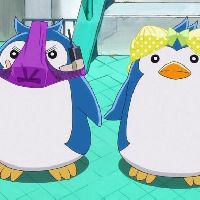This article was written by gchau and edited by 16and and Achachan of the MAL Articles Club.
Interested in writing or editing for us? Click here!
Introduction
Why are we enticed by the idea of time travel? What is the reason that makes it so pervasive in science fiction stories? Whatever the motive is, the possibility of time travel, and especially of traveling to the past, is an idea that has always tempted the human mind. From H. G. Wells' novel The Time Machine, to classic movies like Back to the Future and sitcoms like Futurama, the fascination for this topic in all forms of entertainment is undeniable. Anime is, of course, not detached from the widespread charm of this beloved sci-fi trope. As with other themes in science fiction, there exists a myriad of different approaches for imagining how time travel might develop. In this article, we will discuss some of the major models of time travel in fiction and explore notable examples of each of them in western examples and the anime canon. For the sake of this article, western examples are defined as shows and movies that originate in America. These examples are used to further clarify each model of time travel and offer a comparison to the examples provided for anime.
Time Travel Models in Fiction
Models of time travel in fiction are the different "pseudo-theories" existing in fictional worlds that try to explain the organization of time flow and how the universe supports or adapts to the actions of a time traveler. There are many models of time travel in fiction, but the four main ones are:
Fixed timeline: In this version, there exists a single, stable and fixed timeline. When characters travel to the past and try to alter the flow of events, they can either be prohibited to do so by sheer luck or an all-mighty power, or they were always supposed to alter events in the first place. In this time model, a subtle notion of fate pervades the narrative. One of my favorites examples in western culture is Fry, from Futurama, being his own grandfather after accidentally killing the "real" one.
Time loop: This is one of the most used versions of time travel. Here, the protagonists are doomed to repeat a specific interval of time until they do "the right thing" and escape from the recursion, after which the flow of time returns to normal. For mysterious and/or narrative reasons, the cause behind the time loop are not known or are revealed later. Usually, only the protagonists realize they are trapped in a loop and the actions of other characters repeat in a fixed timeline fashion and they do not retain memories from previous iterations (In this sense, a time loop can be considered a specific version of the fixed timeline model). A concrete example would be the movie Groundhog Day.
Malleable timeline: In this model, there exists one single timeline that can be altered. Characters can travel to the past and perform certain actions that change the subsequent flow of events. Different sub-versions exist where some changes do not significantly affect the outcomes, where time can only be modified at specific points, or where a butterfly effect is triggered with the most insignificant of changes. Maybe the most famous example of this model in western culture is the Back to the Future trilogy.
Multiple timelines: In this model, a large number of parallel timelines exists. They may interconnect at some fixed time points and then diverge. Each time a character makes a change to the continuity of time, a new timeline branches out of the main one. There is the possibility of traveling back and forth in your timeline or, sometimes, between different timelines. A concrete example of western fiction that uses this model would be Star Trek.
Now, we proceed to give notable examples of anime in each of these four categories. Although this classification will make easier the analysis of time travel anime, more than one model can be present in a particular show, and the models might even combine and give rise to more complicated scenarios. Furthermore, there are some instances where, due to lack of official information, the classification considered in the article may be open to other interpretations.
Fixed Timeline

Left: Fumiaki encounters his younger self. Right: Kyon encounters young Haruhi.
Although the timeline changes at the very end, up to the last moments of Occult Academy we witness one pretty unfortunate case of a fixed timeline model. In the near future, Earth has been invaded by interdimensional aliens and the human resistance sends Fumiaki Uchida to the past in order to destroy the "Nostradamus key," the artifact that caused the interdimensional rupture and subsequent extraterrestrial attack. Fumiaki later discovers that what actually triggered this chain of events in the first place was him meeting his younger self.
The "supposed to alter events in the first place" trope is also explored in the Suzumiya Haruhi series. The outrageous adventures in this fan-favorite series start when Kyon's mundane life is interrupted by the transfer of Haruhi Suzumiya to North High School. During the first day of school, Haruhi blatantly mentions that she is only interested in aliens, time travelers, or espers. What fostered this strange obsession? And why does she thinks she can meet them at this high school? Well, the thing is that it may have been Kyon's fault as revealed in the "Bamboo Leaf Rhapsody" episode. In this episode, he travels three years into the past in order to help none other than a younger Haruhi during the Tanabata day. During that event, he says some things that might have triggered Haruhi transferring to North High in order to find a person as interesting as her. This day, July 7th, is later revisited in the Disappearance of Haruhi Suzumiya movie in which this example of fixed timeline model is taken to the extreme.
The time loop

Left: Subaru waking up after experiencing a time loop. Right: Scene from the "endless eight" arc.
In one of the most popular anime of 2016, Natsuki Subaru is suddenly transported to a fantasy world. After a few episodes, he discovers that he possesses the ability to travel back in time when he dies, and only to certain time points in the style of a video game save point. Later, Subaru undergoes a seamlessly endless ordeal to save Emilia and his other friends. One of the most exploitable aspects in the narrative of a time loop is how the recursion of events affects the mental state of the characters, and Re:Zero masterfully leverages this narrative potential and exposes how the constant time repetition and inability of Subaru to set things right put incredible burden on his mental state.
Speaking of mental burden, we cannot possibly forget the infamous "Endless Eight Arc," again of the Suzumiya Haruhi series. Putting aside the strain on the viewer's side, the character that remembered every detail and had to endure the 15, 532 loops was Yuki Nagato. Although the effects of the time loop on her are not immediately apparent, this event starts most of the predicaments explored in the Disappearance of Haruhi Suzumiya movie.
Malleable Timeline

Two screenshots showing the effect of the changes that Satoru made in the past.
We start exemplifying this model with a classic Madhouse movie from the early 2000s. In The Girl Who Leapt Through Time, a young girl named Makoto acquires the ability to go back in time by literally leaping forward, with the momentum of the leap determining how far in the past she can travel. The caveat is that she has available only a limited number of leaps. Throughout the self-discovery journal of Makoto, we witness how she learns to face her own mistakes and that you do not need to go back in time in order to correct your mistakes.
And the topic of mistakes brings us to Erased, one of the most anticipated anime of the 2016 winter season. Satoru Fujinuma is a 29-year-old manga artist who has a strange ability called "revival" that enables him to go back in time just before a specific disaster happens, allowing him to stop it. Normally, revivals only take him back to a few minutes previous to such events. However, when he is framed for the murder of his mother, his "revival" takes him to when he was 11 years old! Now, he has to solve the mysterious death of one of his classmates and find out how it's related to the assassination of his mother. Without going into details, we see that Erased is indeed based on a malleable timeline model, when, after returning from his "revival" Satoru corroborates with a magazine that his actions did affect the past.
Aside from these two examples, this model is also utilized in other famous anime like Charlotte and Puella Magi Madoka Magica.
Multiple timelines

Left: Noein's explanation of multiple timelines. Right: Okabe Rintarou makes a change to the past.
Noein may not be a well-known anime, but it is an excellent example of a multi-timeline universe. The story focuses on two kids, Haruka and Yuu, and their group of friends, who are approached by an order of knights from the future (or one of the possible futures, as they clarify). The knights' dimension, La'cryma, is being invaded by another one called Shangri-La. In order to prevent this, the knights must find the dragon torque. The convoluted relations between the different dimensions is explained in episode 6, where Haruka is told that La'cryma is one of the possible futures and that multiple timelines exist and interlace.
In contrast, one very popular show (indeed, #11 in MAL's popularity ranking at the time of writing) that also exploits the multiple timelines paradigm is The Future Diary. Without going into big spoilers, we can only mention that the final episodes of the series and the Redial OVA show us three timelines whose interconnection stems from the actions of the contestants in this unusual battle royale.
Finally, to end this article on the highest note, we have the epitome of time travel anime: Steins;Gate. I have never seen time travel in animation handled so masterfully and with almost no loose ends. In the first episode, which really is a "Prologue of the Beginning and the End," we are introduced to the "mad scientist," Okabe Rintarou, who, along with the members of his laboratory of future gadgets, discover that their latest invention can send messages to the past using a microwave! The protagonist of this sci-fi thriller will later discover about changing the past, the butterfly effect, and the existence of multiple timelines. All of these combined with excellent characters and psychological drama creates one of the top-ranked anime series of all times.
Conclusion
After this recount of time travel anime, it seems that the overture question of this article gets answered by itself: we, and the protagonists of these stories, are fascinated with time travel for its possibility of rewriting errors, combined with the longing for a brighter future and the best possible version of ourselves and the surrounding world. This underlying topic speaks to our deepest desires as human beings. However, Kyon, Makoto, Satoru, or Okabe do not only leave behind great stories, but also the moral that some errors cannot be corrected and, that more than trying to change the sometimes stone-written past, we must learn from our mistakes and work towards the future that is entirely in our own hands. Maybe time travel as conceived in science fiction will never be feasible, but that will not stop the industry from producing excellent anime that makes the best out of this age-old dream.
Got feedback? Leave a comment here!



